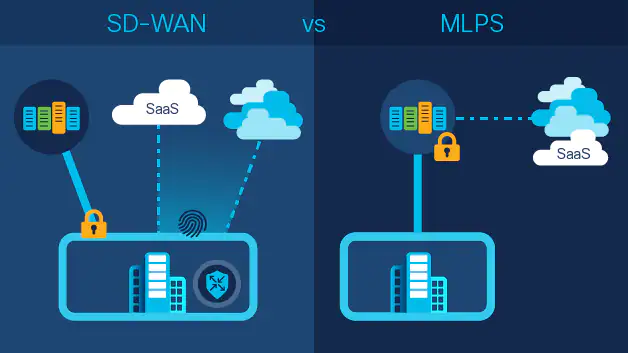A WAN (Wide Area Network) helps bring your branches and offices together. Providing connectivity between many internet leased line connections, WAN is a quick way to send and receive data within your offices located in different cities and also in different countries. But traditional WAN has its set of limitations, leading to the arrival of SD-WAN (Software-Defined – Wide Area Network). Read through to know more about traditional WAN and SD-WAN and how the two networks differ.
What Is Traditional WAN?
The traditional WAN is completely dependent on hardware devices like Multi-Protocol Label Switching (MPLS). The hardware ensures a flexible and efficient flow of network traffic. It requires the installation of several hardware devices along with proprietary circuits to connect IP services and intended clients. A traditional WAN connects many Local Area Networks (LANs) and Virtual Private Networks (VPNs) and enables users to prioritise data, voice, and video traffic on the network. But security issues and management difficulties pose to be major problems and thus pave the way for an upgraded network, the SD-WAN.
What Is SD-WAN?
SD-WAN or the Software-Defined Wide Area Network is backed by software to manage the Wide Area Network. Right from connectivity to management and providing service, the entire SD-WAN network is controlled by software. SD-WAN scores over traditional WAN and acts as a global network that provides a better and more secure application performance. It also optimises cloud connectivity and simplifies management. It is thus considered the optimal way of routing information.
Traditional WAN Vs SD-WAN – Differences
Choosing the ideal network for your business can be confusing. In order to better understand the two technologies, here is a brief explanation of their differences.
Technology
As the name suggests, Traditional WAN confers a conventional approach to managing the Wide Area Network. On the other hand, SD-WAN relies on software-defined technology to manage the Wide Area Network.
Flexibility
A WAN network cannot be manoeuvred and therefore lacks flexibility, whereas, SD-WAN provides better flexibility in WAN management.
Configuration Process
In a WAN network, the configuration process and scaling up of new devices is slow and tedious. However, it is swift, easy and quick in the case of SD-WAN.
Dependence On Human Skill
The configuration process of a WAN network can be done only by skilled personnel. This involves high dependence on human intervention. On the other hand, SD-WAN networks are configured automatically sans any human intervention.
Performance Speed
Traditional WAN networks work by connecting to the intermediate hub and then to the cloud. This causes low performance when connecting with cloud-based applications. Whereas SD-WAN enjoys a high performance as it can directly access the applications hosted in the cloud.
Data Centre Capacity
The data centres under a traditional WAN network are limited in their capacity, implying a restriction on dealing with connections coming from multiple cloud platforms. Whereas, data centres in SD-WAN are not limited. This is because of the underlying hardware that makes up the SD-WAN network.
Degree of Complexity
Traditional WAN is highly complex when it comes to management, configuration and infrastructure arrangement. On the contrary, the complexity associated with the management, configuration and infrastructure arrangement of SD-WAN is low.
Secure VPN
Traditional WAN networks do not provide secure Virtual Private Networks (VPN). They also fail to integrate the additional features like firewall, Wan Optimization, and SWG into the system. Whereas, the SD-WAN solutions offer a more secure network and integrate all additional features.
Security
The traditional WAN network is secured by an MPLS connection. On the contrary, SD-WAN ensures secured data traffic through end-to-end encrypted data transmission over a VPN connection.
Why Is SD-WAN A Better Network?
SD-WAN is a network that runs atop another network. It overlaps an existing network and therefore promises agility and speed of provisioning to the WAN. This brings down the total cost of the WAN network.
The other advantages that an SD-WAN network offers include:
Reduces Circuit Cost
WAN networks rely on hardware devices namely the Multi-Protocol Label Switching (MPLS). SD-WAN technology eliminates this and therefore reduces circuit cost. Instead, it uses low-cost, high-speed options for connectivity like broadband or DSL.
Adopts Cloud-Based Services
As in the case of WAN, the data traffic is routed back to the data centres. This increases the need for constant filtering which results in sub-optimal routing and potential latency issues. But as the SD-WAN directly accesses the applications hosted in the cloud, it reduces all such limitations.
Real-Time Traffic Monitoring
The direct access to applications hosted in the cloud makes way for assured and simplified QoS. This ensures real-time traffic monitoring and diverts business-critical traffic during lags if any.
Supports High Bandwidth Technology
The ability to hold up high-bandwidth intensive applications concurrently proves to be a real plus point for SD-WAN as high bandwidth requirements pose a real challenge for traditional WAN.
Conclusion
WAN is a communication platform. It connects different internet leased line connections, LANs and VPNs to enable users to prioritise data, voice, and video traffic on the network. This facilitates organisations to communicate between branches and offices to help them stay connected and updated. But changing and ever-evolving internet needs have caused the traditional WAN to choke. The superior technology of the SD-WAN network thus proves to be a better technology for your growing business needs.
FAQs
Do I need to change my service provider for SD-WAN?
No, you do not need to change your service provider for setting up an SD-WAN network. It is a software enhancement that runs atop the traditional WAN network.
Why should I choose SD-WAN for my business?
SD-WAN network is a virtual WAN architecture. It is an upgrade over the traditional WAN network. The advantages include:
- Reduced circuit cost
- Offers cloud-based services
- Allows real-time traffic monitoring
- Supports high bandwidth technology
Is SD-WAN better than WAN?
SD-WAN is an enhancement above the traditional WAN. It optimises cloud connectivity and simplifies management. It enables businesses to deploy wide area networks that are 100 times faster and 3 times more cost-effective.
How is the SD-WAN network maintained?
The SD-WAN network is software driven. It is configured automatically without any human intervention. Furthermore, the SD-WAN network is centrally controlled. So, the traffic is directed across the WAN securely and intelligently directly to trusted SaaS and IaaS providers.
How does SD-WAN improve security?
SD-WAN networks ensure the safe and secure movement of data. The data is transmitted through end-to-end encrypted tunnels which are created between every site in the SD-WAN network. It also takes advantage of the SSL security provided by the SaaS application.








